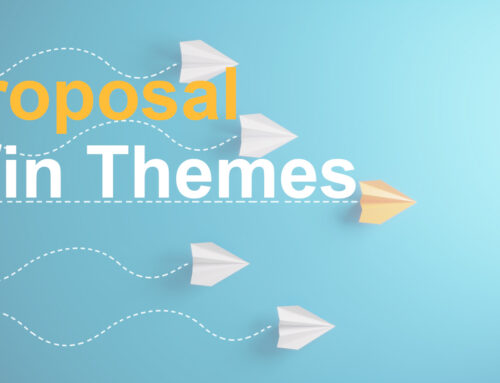Yet in that time, a few things have changed. Things like YouTube, Flip video cameras, Prezi, thumb drives, Adobe Premiere, high-bandwidth Internet, Personal URLs (PURLs), Google SketchUp, SaaS, iStock Photo, social media… There’s a whole new world of opportunity to communicate, demonstrate, create insight, generate consent, and in general impress the hell out of prospective customers.
Despite this new set of tools, few companies have changed the fundamentals of how they inform, influence and motivate at the critical proposal stage of the sales cycle. We think that creates an opportunity for those willing to break out.
Tomorrow’s proposal; what will it be?
Many professionals have been in the proposal time capsule for so long that it may be hard to envision how proposals can change. So let’s create a vision for the future.
The best future vision we’ve seen yet is that of proposal guru Tom Sant, founder of the proposal automation software, ProposalMaster: “I believe that at some point in the next few years, proposals will be true digital documents – more like Web sites than Word documents. They will feature embedded video clips, hyperlinks, search capabilities, and other functionality that will make them interesting and easier to use.”
Digital documents such as these can be delivered in two ways:
- Virtually, by linking to a proposal landing page. The landing page – perhaps a different PURL for everyone who receives a copy – contains a set of customized links that serve as a Table of Contents for the proposal “document.”
- Physically, in the form of thumb drives that contain the entire proposal package, as well as any software needed to access and view the contents. This may be an acceptable alternative for organizations – primarily public entities – that require physical delivery of proposal documents in order to meet statutory requirements.
Either way, digital documents offer another advantage that’s increasingly important: saving a few thousand acres of trees every year.
Customization: the killer app for digital proposals
The real power of digital documents is the ability to enable every recipient to “read” a proposal in their own way. Even if every copy of a proposal is the same for every recipient (sometimes that’s a requirement), providing information in multiple formats enables every reader the ability to absorb in a way most suited to them: narrative, illustrations, video demonstrations, bullet-point slides, schematics, configurators . . . even collaborative spaces.
The key organizing principle is the function of each individual, followed by likely personal characteristics, which combine to drive the type of content and method of delivery. Here’s a sample:
|
Buyer Type |
Characteristics/Wants |
Include in the Proposal |
|
Technical Buyer |
Detail-oriented, leaning toward logical, narrow-focus; wants to know how your solution works. |
Technical proposal narration, product specifications and schematics, demo video, technical FAQs |
|
Operational Buyer |
Bigger picture interest, leaning toward creative, integration-focused; wants to know how your solution fits. |
Operational proposal narration (with bullet-point summary), product configurator, tactical ROI calculator, operational FAQs, demo video |
|
Financial Buyer |
Subject-specific, left-brain, may focus on strategic (as well as tactical) value: wants to know what your solutions cost (and, perhaps, a cost/value equation) |
Cost proposal (including lifecycle costs), tactical and strategic ROI calculator, product specifications (especially those that impact value equation) |
|
End User |
Agenda-driven, emotional investment, narrow focus; wants to know how your solution impacts his/her job. |
Product demo, product specifications and schematics, user-focused FAQs |
|
Executive Approver |
Time-stressed, strategic thinker, leaning toward creative; wants to know how your solution changes the game. |
Demo, strategic ROI calculator, bullet-point summary |
Unless you have a clairvoyant on staff, you may not be sure which buyer type consumes which type of content. Accordingly – unless otherwise required by an RFP – all of the proposal elements can be included in all proposal documents delivered to the buying organization. Each reader will find their own way through the digital document…but all will appreciate your thoughtfulness for giving them what they really want.
Real customization happens on the landing page, especially if proposal recipients get their own personal URL (PURL). Imagine clicking on a PURL and this happens: A video spokesperson welcomes the recipient by name and briefly goes through the Table of Contents, emphasizing content likely to be of specific interest. As each element is named, the link is highlighted and a thumbnail of the contents pops up. If a recipient wants to “jump the curve” and click directly, the video ends immediately and navigation takes them there. They never get the video again, unless they specifically click on the link. Proposal navigation provides ‘bread crumb” navigation so no reader gets lost, and the Table of Contents highlights visited sections so they can pinpoint what hasn’t been viewed or read. Finally, a robust search capability is embedded in the presentation to allow any recipient to drill down to very specific details.
Each recipient does this differently, of course, and – if tracking is enabled – the selling organization knows what each one viewed (or interacted with) and for how long. From this, you can learn:
- What each person knows – and doesn’t know about your solution
- Some personality characteristics of each recipient
- Possible issues with your solution, based on attention paid to – or searches on – specific topics
What’s in the way?
After this idyllic view, what’s holding all of us back from implementing digital proposals with these capabilities? The same reason we have the 140-year-old QWERTY keyboard on our computers. Even though it’s inefficient, we’re used to it, and it takes too much effort to change.
Proposals will change, albeit slowly. First, we’ll embed clickable links for non-essential information. Then we’ll begin migrating more information – presented in a more interesting fashion – through those links.
Finally, when technology providers begin to bundle production tools into a single, flexible, interactive platform that enables sellers to cost-effectively embed rich media into proposals, the rush will be on. And paper-based proposals will join the growing “whatever happened to…” lists of pre-digital artifacts.





Leave A Comment